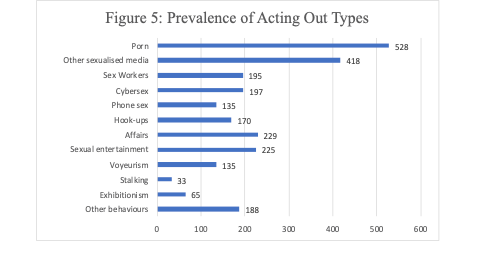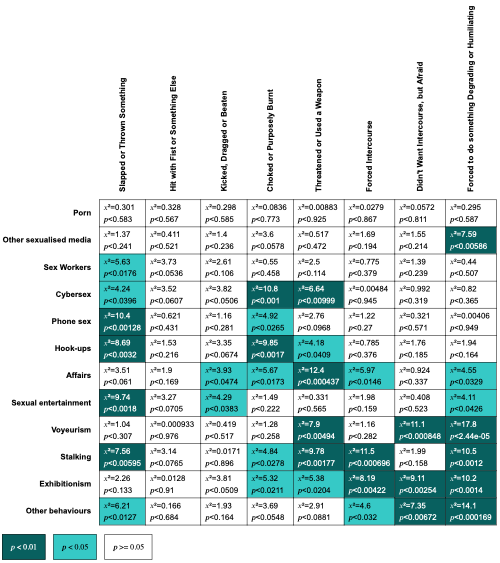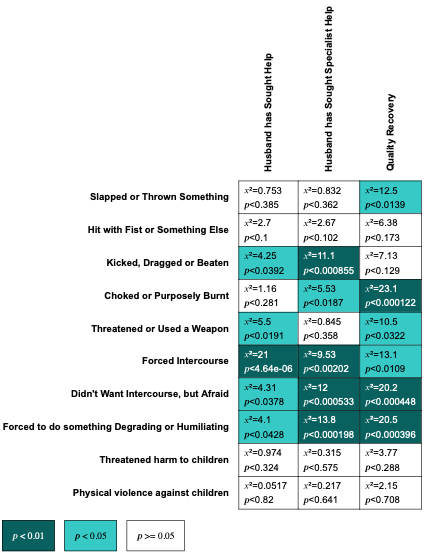Today we finish our look at the results of my Masters in Counselling study on domestic violence in the lives of partners of sex addicts. Next week I'll give some thoughts on "what it all means" for PSAs (and SAs).
Associations between acting out type and violence
In this study I decided to test my hypothesis, based on my own observations, and backed up by other studies, that more extreme forms of sexual acting out, i.e., particularly sex offending behaviours, would be associated with IPV perpetration, and possibly severe IPV perpetration.
As previously mentioned, participants were asked to select which types of behaviours they knew their SA partner’s acting out to include. The graph below shows their responses.

I looked at whether the variables on the SA’s acting out behaviours, as reported by participants, could be found to produce any statistically significant associations with the various forms of violence.
In Chi-square analysis, highly statistically significant associations were found between:
- All illegal forms of acting out (stalking, voyeurism and exhibitionism – variables which had statistically significant associations with each other) and both IPV and severe IPV. The odds ratio showed that the odds of IPV perpetration by those reported as having these illegal behaviours was 1.99 times higher than for those who were not reported as having them. These odds increased to 2.28 times higher for severe IPV perpetration.
- Acting out with other people (affairs, sex workers, cybersex, phone sex, hook ups) – variables which had statistically significant associations with each other— and physical violence ever. The odds ratio showed that the odds of IPV perpetration by those reported as engaging in these SA behaviours was 1.31 times higher than those who did not (according to their PSA partner) engage in them. Affairs alone was shown to have a statistically significant association with five, out of the ten, of the IPV measures—an amount exceeded only by stalking (6) and exhibitionism (6). For more on these results, see the table below.
- Use of “other (besides internet porn) sexualised media” and being forced to do something degrading or humiliating. The odds ratio showed that those using sexualised media were 1.82 times more likely to be reported as forcing their partner to do something sexually degrading or humiliating.
For a breakdown of these and other statistically significant (p < 0.05) and highly statistically significant (p < 0.01) associations between acting out behaviours and IPV, see the table below. The darker (green) the color, the stronger the association between the two variables.

Recovery behaviors
Next I tested my hypothesis, “the SA’s engagement in specialised therapy, or other mental health support, would be a mitigating factor for current violence.” Figure 17 below shows the number of participants who said that their husband/partner was not seeking help versus the number who said he was, and what kind of help.

This hypothesis turned out to be correct with regards to:
- Seeking specialist support and current sexual violence. The odds ratio showed that the odds of an SA partner perpetrating sexual violence in the last year was 2.60 times higher if he had not engaged in specialist support.
- Seeking any mental health support (including specialised support) and current sexual violence. The odds ratio showed that the odds of an SA partner perpetrating sexual violence in the last year was 2.24 times higher if he had not sought any type of support.
- Seeking specialist support and current physical violence. A look at the odds ratio indicates that the odds of an SA partner perpetrating physical violence in the last year were 1.98 times higher if he had not engaged in specialist support.
No association could be found between “seeking (any) mental health support” and “current physical violence.”
For a breakdown of these and other statistically significant (p < 0.05) and highly statistically significant (p < 0.01) associations between the SA partners’ support seeking behaviours and IPV, see Table 4 below. This table also show the the correlation between women's current experiences of violence (measured by whether she had experienced violence in the last 12 months) and how she answered a question on the quality of her husband's recovery. The darker (green) the color, the stronger the association between the two variables. In this case the association is "inverse," in other words men with this kind of help were less likely to be found to have engaged in this type of violence.

Not to sound like a broken record, but please remember your self-care or seek support if any of what you've read feels triggering. Next week we will start considering what the results of my Masters study have to teach us.


